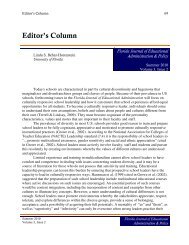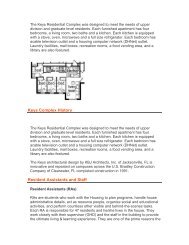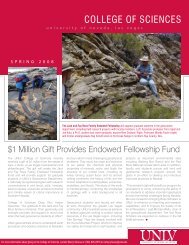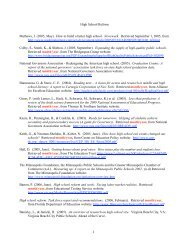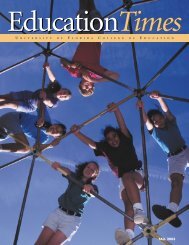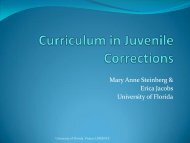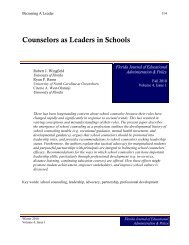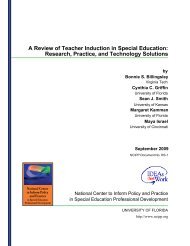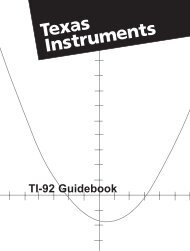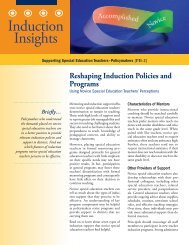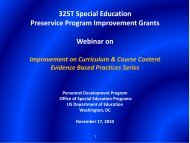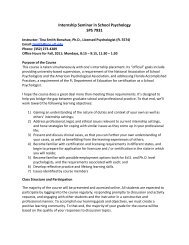Revival - College of Education - University of Florida
Revival - College of Education - University of Florida
Revival - College of Education - University of Florida
- No tags were found...
You also want an ePaper? Increase the reach of your titles
YUMPU automatically turns print PDFs into web optimized ePapers that Google loves.
facultyKRISTEN BARTLETT GRACE/UF Photography20Teacher <strong>of</strong> the YearAWARDSTerzian garners college and campuswide honors.Mary Ann Clark• Graduate Teacher <strong>of</strong> the Year08honorsSevan Terzian• UF <strong>University</strong> Teacher <strong>of</strong> the Year• COE Undergraduate Teacher <strong>of</strong> the YearWhat do Native American boarding schools, 1950s mental hygienefilms and the Booker T. Washington/W.E.B. Du Bois debatehave in common? They’re all part <strong>of</strong> the history <strong>of</strong> American education—andthey’re all things Associate Pr<strong>of</strong>essor Sevan Terzian usesto teach his undergraduate students how our schools became whatthey are today.Terzian, known for his innovative approaches to teaching educationhistory, has been named a UF <strong>University</strong> Teacher <strong>of</strong> the Year.The honor—given each year to only one or two pr<strong>of</strong>essors amongthe UF’s entire faculty—came to Terzian just a few weeks after the<strong>College</strong> <strong>of</strong> <strong>Education</strong> named him its 2008 Undergraduate Teacher<strong>of</strong> the Year.Students <strong>of</strong>ten report that Terzian’s is the hardest course they’veever taken—and the most rewarding—and colleagues have expressedadmiration for Terzian’s ability to build well constructedclassroom experiences.Outside the classroom, Terzian has devoted much <strong>of</strong> his researchcareer to the study <strong>of</strong> the history <strong>of</strong> the American high school, witha focus on attitudes about science, gender and education in thepost-WWII era. Terzian has been at UF since 2000, and he holdsdoctorates in American studies and the history <strong>of</strong> education fromIndiana <strong>University</strong>.LARRY LANSFORD/Ed TimesSchool psychology group cites Joycefor gender learning gap researchDoboys really lag behind girls in reading achievement,and do girls really lag behind boys in math?Diana Joyce, an assistant scholar in UF’s Department<strong>of</strong> <strong>Education</strong>al Psychology, took another look at this bit <strong>of</strong>conventional wisdom. The results earned her the PsychologicalCorporation/National Association <strong>of</strong> School Psychologists’ inauguralJunior Faculty <strong>of</strong> the Year Award.Joyce analyzed 8,000 test scores from the Woodcock-JohnsonTests <strong>of</strong> Achievement, widely used in school evaluations to measureacademic achievement. She wanted to use the large sample to takea closer look at widely accepted notions about race, gender andachievement in different academic subjects. With women now ahead<strong>of</strong> men in college enrollment, and major reforms going on in K-12education, were the old assumptions about boys and girls still valid?“Past studies had shown girls ahead in reading and there is alwaysthe contention that boys are generally ahead in math,” she said. “Iwanted to see if that was still happening, and I wanted to break theresults down by ethnicity.”She found that, in this sample at least, the old trends generallyheld true. Girls performed better in reading and writing, while boysmaintained a hold to their claim on better math scores in somenarrow skill areas such as applied math problems. National scoresindicate girls are actually gaining some ground in math, but boys stillgenerally performed better on some senior-level math aptitude tests.“Probably the most significant finding was that the gender differencesheld true across ethnic groups, which would indicate that thisis indeed a gendered issue,” Joyce said.Joyce said her study’s results don’t mean that boys are innatelybetter at math, or girls at reading. The preponderance <strong>of</strong> boys inremedial reading classes may mean that early interventions for boysneed to be improved, she said. Or boys may be turned <strong>of</strong>f by a readingcurriculum that is more attuned to girls’ interests.The reasons for girls’ post-secondary math performance are a littleclearer. Studies clearly show that while girls, on average, get goodgrades in math classes, they sometimes don’t elect to take prerequisiteadvanced math courses and are underrepresented in STEM (sciencetechnology-engineering-mathematics)career program enrollment.The reasons why are murky, but they’re something Joyce would liketo study.“I know that in interviews, girls <strong>of</strong>ten say they want a career thathelps people,” said Joyce, who also works as a school psychologist atP.K. Yonge Developmental Research School, UF’s K-12 laboratoryschool.“One hypothesis is that girls stay away from math and scienceclasses because they don’t see them as disciplines that are people-oriented,”Joyce said. “We need to remind them that STEM (science,technology, engineering and mathematics) disciplines are about morethan building roads or bridges – these skills can be used in fields likemedicine to help people in a direct way.”Award-winning research by Diana Joyce (shown, right, helping one <strong>of</strong> herstudents) suggests the perceived gender learning gap is indeed valid.FAMU names buildingfor former pr<strong>of</strong>essorFormer UF education pr<strong>of</strong>essor Walter L. Smith has receivedone <strong>of</strong> the highest honors a university can bestow. <strong>Florida</strong> A & M<strong>University</strong> has renamed its architecture building after Smith, whoserved as the university’s president from 1977 to 1985.At FAMU, Smith was best known for expanding the college’sprograms and establishing the university’s first doctoral program.Smith says his push for new campus facilities in the 1980s, at atime when the Board <strong>of</strong> Regents was reluctant to fund new facilitiesthere, was probably the reason FAMU’s architecture facultyrequested their building be named in his honor.Smith also is a FAMU alumnus, earning his bachelor’s degreethere along with a doctorate from <strong>Florida</strong> State.After leaving the presidency <strong>of</strong> FAMU, Smith traveled to postapartheidSouth Africa to help that nation establish a communitycollege system. That project was ongoing in 1995, when he joinedthe faculty <strong>of</strong> UF’s <strong>Education</strong>al Leadership and Policy department.At UF, Smith’s community college expertise provided a valuablecontribution the Institute <strong>of</strong> Higher <strong>Education</strong>. He retired fromUF in 2000 and now lives in Tampa, where he bought a buildingin his old neighborhood and turned it intoa library for neighborhood children.Her students describe her as genuine, candid and caring. Herresearch gets to the heart <strong>of</strong> one <strong>of</strong> most perplexing mysteries ineducation today.Small wonder that Mary Ann Clark, an associate pr<strong>of</strong>essor inCounselor <strong>Education</strong> and B. O. Smith Research Pr<strong>of</strong>essor, has beenselected as the UF <strong>College</strong> <strong>of</strong> <strong>Education</strong> Graduate Teacher <strong>of</strong> theYear for 2008.A lead investigator on international, national, and local researchon male underachievement, she has involved her students in actionresearch in local schools, encouraging them to present and publishtheir collaborative work. Clark makes sure her students acquire realworld knowledge <strong>of</strong> the pr<strong>of</strong>ession and encourages them to takeresponsibility for contributing to interventions and solutions forissues in schools as they prepare to become pr<strong>of</strong>essionals.Smith (left) with DavidHorton, the 2007Clark has authored or co-authored 34 publications, includingrecipient <strong>of</strong> a COEthree books, and has made numerous regional, national and internationalpresentations on four continents. As one student stated,scholarship createdby Smith.“She makes you feel like you are important. Consequently, Dr.Clark’s students strive to do their best for her.”Clark, center, with graduate students Heather Adams, left, and Erin Oakley.— Tim Lockette28 <strong>Education</strong>Times Fall / Winter • 2008 Fall / Winter • 2008 <strong>Education</strong>Times 29KRISTEN BARTLETT GRACE/UF Photography



